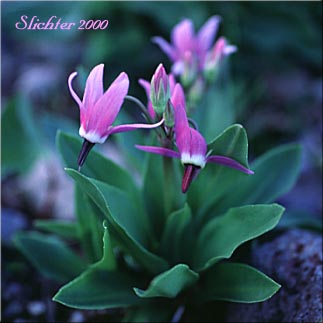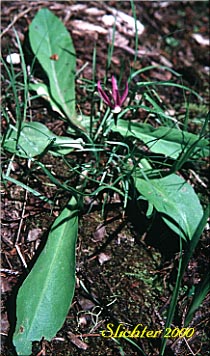

 Photo
at right of Jeffrey's shooting star along the Paradise Park Trail, Mt. Hood N.F......July,
1990. Note the oblanceolate leaves with tapered petioles.
Photo
at right of Jeffrey's shooting star along the Paradise Park Trail, Mt. Hood N.F......July,
1990. Note the oblanceolate leaves with tapered petioles.
Jeffrey's shooting star is an attractive perennial with a basal rosette of leaves and an erect stem to 50 cm in height. The herbage is smooth-surfaced to densely glandular-pubescent. The leaves are oblanceolate with a pointed or rounded tip. The leaves gradually narrow to form long, winged petioles about 6 mm wide. The leaves range in length from 5-40 cm.
The 3-20 flowers usually have 5 floral parts, but on occasion may have 4 floral parts.. The corolla lobes are 1-2.5 cm long and purple, lavender, yellowish, or white. The tube at the base of the petals is lighter in color than the corolla lobes, and is often white. The filaments are deep red to blackish-purple, up to 1 mm long and free or shallowly united with the anther connectives transversely wrinkled. The anthers are 6-10 mm long and are yellow to reddish. The stigma at the tip of the style is enlarged and "pin-head" -shaped.
This species is very similar to alpine shooting star which has 4 floral parts. Jeffrey's shooting star seems to be fairly commonly available at native plant nurseries, and makes a nice addition to the rock garden or backyard meadow.
Jeffrey's shooting stars are found in moist meadows and along streambanks in subalpine to mountainous areas within its range.
Jeffrey's shooting star may be found from Alaska south in the mountains through the Cascade and Olympic Mts to the southern Sierra Nevada Mts. of California, and east to Idaho and Montana.
In the Columbia River Gorge, it may be found from near Larch Mt in the west to Mt. Defiance in the east, and is found at elevations ranging from 2800'-4400'.